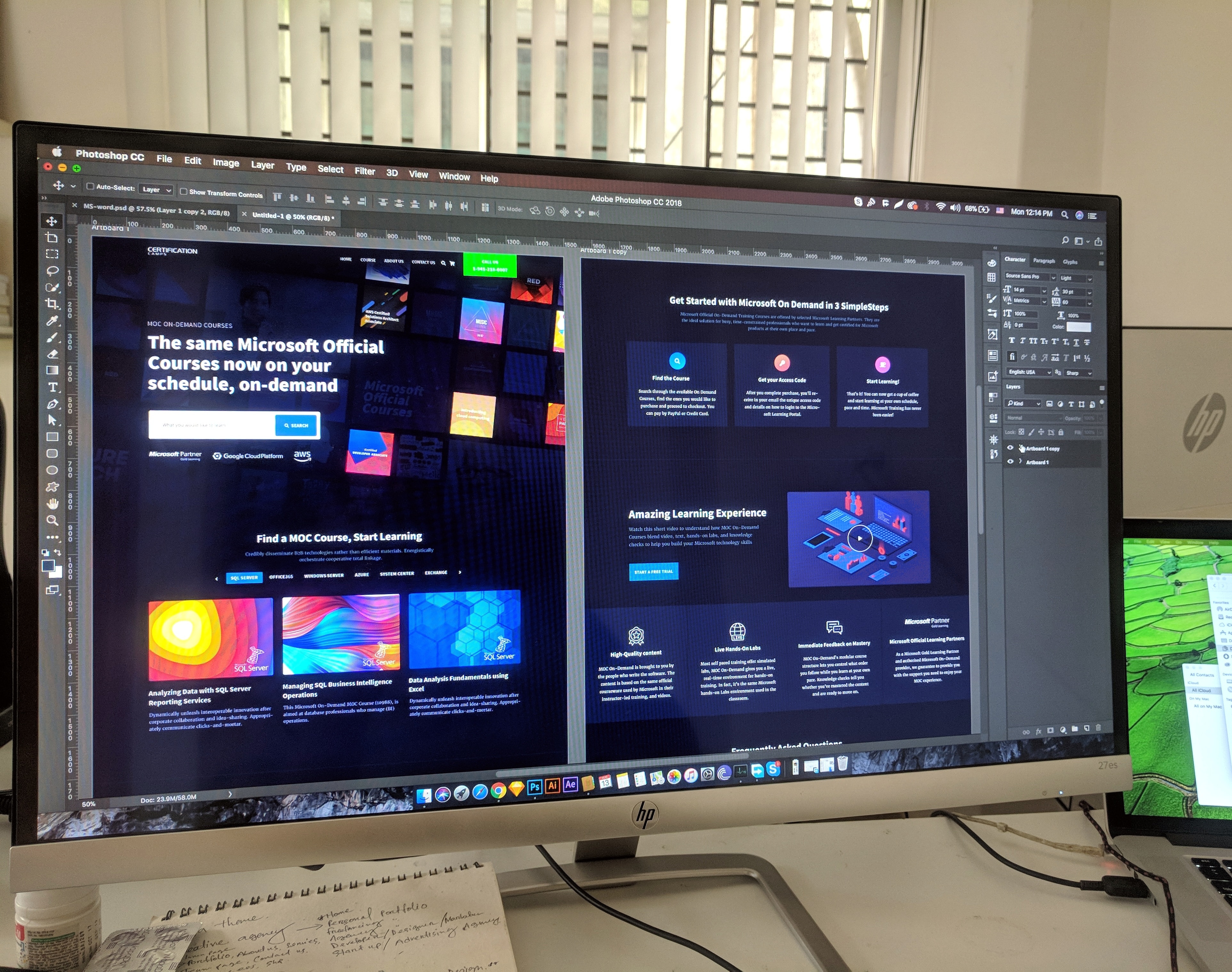

Akim Perminov
Certified Squarespace expert
Website Design Benefits in 2024: Enhancing User Experience and Conversion Rates
In the digital age, website design has become an integral part of business strategy. A website often serves as the first point of contact between a company and its potential customers. An effective design can set the tone for the user experience, branding, and the perception people have of a company.
Elements such as color schemes, font choices, and layout come together to create a digital environment that can either engage visitors or drive them away.
The benefits of a well-designed website extend beyond aesthetics. With the right design, businesses can improve their lead generation and conversion rates. Incorporating essential web design elements enhances not only the visual appeal but also the functionality of the website.
Features such as navigation menus, responsive design, and clear calls-to-action directly contribute to a user-friendly experience.
Moreover, the integration of good website development and search engine optimization (SEO) practices in the design process is crucial. A well-optimized website ensures greater visibility in search engine rankings, increasing the likelihood of attracting more visitors. Investing in professional web design is an investment in a business's online presence and its future growth.
Enhanced User Experience
An enhanced user experience (UX) directly contributes to customer satisfaction, loyalty, and conversion rates. A meticulously designed UX strategy combines aesthetics with functionality, ensuring users find value in what they interact with.
Intuitive Navigation
Users should find what they're looking for in a website with ease. Intuitive navigation implies a clear, logical layout of menus and submenus. This element of design includes consistent placement of items and well-categorized content. Lists and dropdowns are often employed to achieve this clean structure.
Responsive Design
A website must look and function flawlessly across all devices and screen sizes, which is where responsive design comes into play. This ensures that the user's journey remains consistent whether they are on a smartphone, tablet, or desktop. Media queries, flexible grid layouts, and scalable images are key technical aspects of responsive design.
Fast Load Times
Users appreciate quick access to content, which means fast load times are crucial. A delay of even a few seconds can increase bounce rates dramatically. Strategies to achieve quicker load times include the optimization of image sizes, the use of content delivery networks (CDNs), and the minimization of HTTP requests.
Improved Search Engine Rankings
Optimal website design is integral for enhancing search engine rankings. Strategic design choices are pivotal for SEO performance and can significantly affect a website's visibility in search engine results.
SEO-Friendly Architecture
A website's structure can determine its ease of indexing by search crawlers. SEO-friendly architecture relies on a clean, logical structure with a clear hierarchy. This structure should utilize:
Headings: Accurate use of
<h1>to<h6>tags to reflect content importance.URLs: Descriptive and keyword-relevant URLs for better indexing.
Internal Linking: Strategic use of links to connect content and distribute page authority.
Mobile Optimization
With the increase in mobile internet users, mobile optimization has become a non-negotiable element for higher search rankings. Features of a mobile-friendly website include:
Responsive Design: The layout adjusts fluidly across devices and screen sizes.
Touch-Friendly Navigation: Menus and buttons are easily navigable on touch screens.
Fast Load Times: Efficient design to reduce loading time, as prolonged load times can lead to higher bounce rates.
Increased Credibility and Professionalism
A website's design directly informs users about the company's credibility and professionalism. Through consistent branding and professional aesthetics, a company can establish trust and convey its expertise.
Consistent Branding
Logo & Color Scheme: A professional web design ensures that a company's logo and color palette are uniformly integrated across all pages, solidifying brand recognition and coherence.
Typography & Imagery: The consistent use of fonts and high-quality images reflects a commitment to detail and brand consistency, further enhancing credibility.
Professional Aesthetics
Layout & Navigation: A structured and intuitive layout with clear navigation paths demonstrates a company's professionalism, showing respect for the user's time and needs.
Visual Harmony: Strategic use of white space and balance between text and visuals creates an appealing and professional look, encouraging higher levels of trust and user engagement.
Greater Accessibility
Greater accessibility in website design ensures that all users, regardless of their abilities or the devices they use, have equivalent access to information and functionality.
Cross-Browser Compatibility
Websites that adhere to W3C Web Accessibility Initiative (WAI) guidelines are more likely to be compatible across various browsers. This means that the website functions well whether one is using the latest version of Chrome, Firefox, Edge, Safari, or others.
Cross-browser compatibility ensures that users have a consistent experience, preventing exclusion based on the technology they choose or have access to.
Assistive Technologies Support
Providing support for assistive technologies allows individuals with disabilities to interact with content in ways that suit their needs. This includes screen readers, alternative keyboards, and speech recognition tools.
Designing with assistive technologies in mind involves following established guidelines, such as the WCAG 2.0, which is an international standard for web accessibility recognized as ISO/IEC 40500. By doing so, designers ensure the website is navigable and understandable for everyone.
Effective Communication of Brand Message
Website design is a pivotal factor in the effective communication of a brand’s message. It leverages visual elements and content structure to ensure the message resonates with the target audience.
Strategic Use of Visual Elements
Visual elements play a crucial role in how a brand’s message is perceived. Color schemes, logos, and images are not merely decorative; they convey the brand's values and personality.
A well-chosen color palette can evoke specific emotions and associations, making the brand more memorable. Logos need to be simple yet impactful, reflecting the brand's essence at a glance. High-quality images and graphics should reinforce the message and be aligned with the verbal branding for cohesion and consistency.
Content Layout and Hierarchy
The way content is organized on a website dictates how easily a user can digest the brand’s message. Content hierarchy ensures that the most important information is noticed first, often through the use of:
Headings: Bold and distinct to grab attention.
Subheadings: Clearly outline the subsections of content.
Bullets and Lists: Break down complex information into easy-to-read points.
Call-to-Action (CTA) Buttons: Prominent and compelling, nudging users towards a desired action.
Analytics and Reporting
In the realm of website design, analytics and reporting form the backbone of strategic decision-making. They offer clear, actionable data that provide insights into user behavior and website performance.
Behavioral Insights
Website analytics tools give designers a deep dive into user interactions on a site.
By examining metrics such as page views, bounce rates, and time spent on pages, businesses can glean how users interact with their content. For instance, a high number of page views coupled with a low average time on page could indicate that while content is initially engaging, it may lack depth or relevance to keep visitors interested.
Most Engaged Content: Lists top-performing pages by user engagement.
Navigation Paths: Tracks the journey users take through the website, highlighting potential friction points.
Performance Tracking
Analytics serve as a performance dashboard, presenting real-time data on how effectively a website meets its objectives. Key performance indicators (KPIs) such as conversion rates, traffic sources, and completed actions provide a quantitative measure of success.

These KPIs help businesses adjust their strategies, refine their marketing campaigns, and allocate resources more effectively to areas that have proven successful in driving growth and conversions.
Conversion Optimization
Conversion Optimization is crucial in web design as it directly influences the ability of a website to fulfill its primary objective—converting visitors into customers or leads.
Call to Action Placement
Effective Positioning: Strategically placed calls to action (CTAs) can significantly affect user engagement and conversion rates. They should be prominently displayed and easy to find.
Consistency and Visibility: CTAs should maintain consistent design elements and be visible without scrolling, often referred to as being "above the fold."
Landing Page Creation
Focused Content: Landing pages must be crafted with a singular focus to guide visitors towards the conversion goal, such as signing up or making a purchase.
Streamlined Design: The design should minimize distractions and use clear, compelling headlines, with bullet points to emphasize key benefits.
Frequently Asked Questions
The Frequently Asked Questions section addresses core concerns regarding the intersection of web design and business strategy, focusing on design's impact on a company's success, brand, and customer relations.
Why is web design critical for the success of a business?
Web design holds significant weight in business success as it serves as the digital facade of a company. An appealing and functional website design can attract and retain customers, directly influencing a business's growth.
What are the top benefits of custom website design and development for businesses?
Custom website design ensures a business stands out with a unique online identity, tailored to their specific audience and business needs. This personalization can lead to better customer engagement and stronger brand loyalty.
How does effective web design contribute to a business's online presence?
Effective web design consolidates a business's online presence through cohesive aesthetics, intuitive navigation, and optimized performance across devices. This results in higher visibility and improved user experience.
In what ways can website design impact a company's brand representation?
Website design is a direct extension of a company's brand. It conveys values and personality through visuals and user interactions. Consistent design elements reinforce brand recognition and trust among audiences.
What role does website design play in user experience and customer retention?
Good web design fosters a positive user experience by streamlining navigation and minimizing frustration. This enhances satisfaction and encourages repeat visits, which are key factors in customer retention.
How can good web design enhance the functionality and performance of a business website?
Good web design prioritizes website performance. It optimizes loading times, ensures compatibility across various devices, and features an organized structure that facilitates easy access to information. This boosts usability and customer satisfaction.










